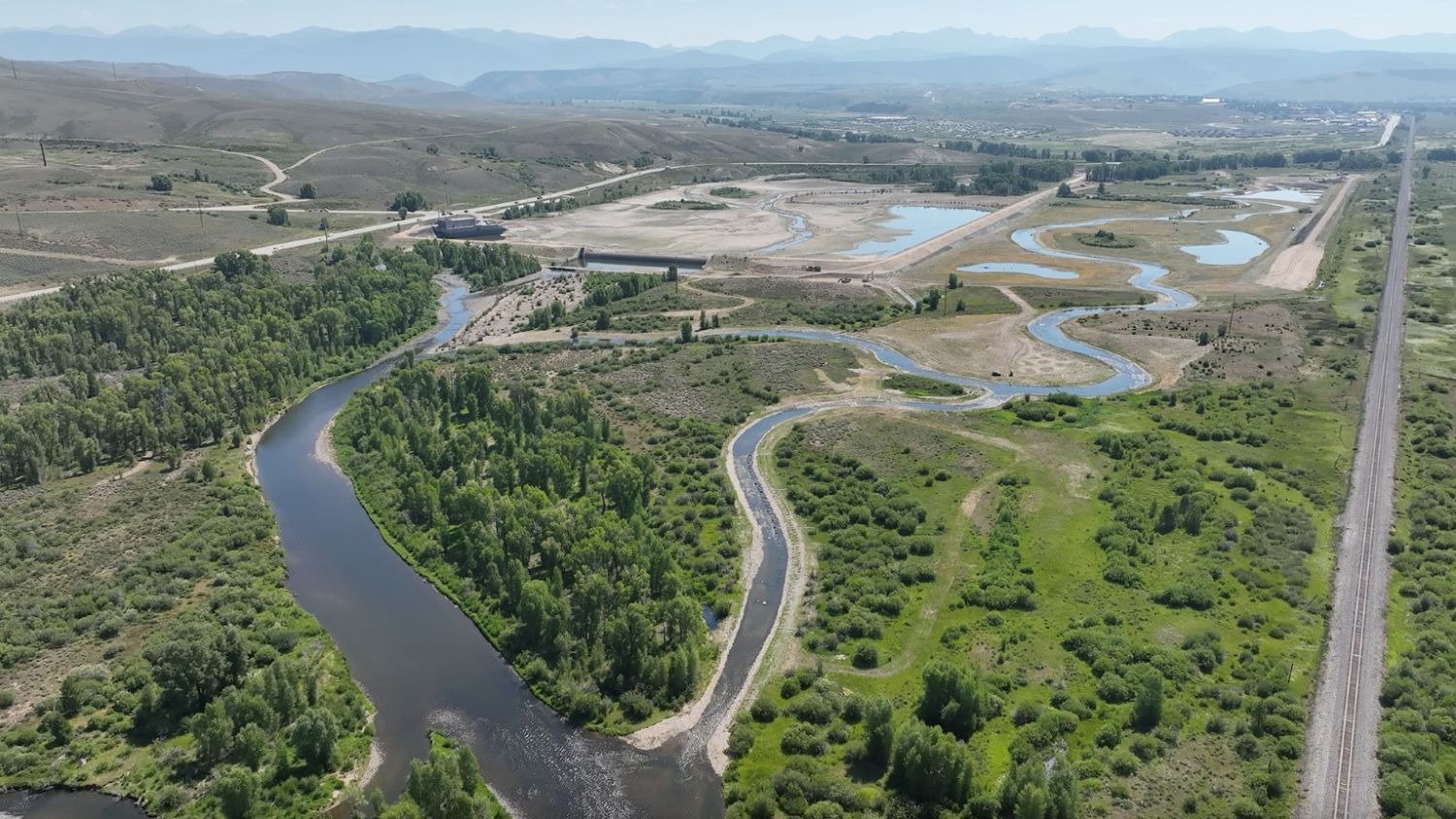Whether you fish or just simply understand the value of clean water, there is no law more important than the Clean Water Act.
Greenback Spawning at Zimmerman Lake - Success!
FORT COLLINS, CO – It was still dark out when I threw the thermos of coffee into the truck and left Denver for the Zimmerman Lake Trailhead just east of Cameron Pass. The goal for the day was to join two other fellow TU volunteers and work alongside Colorado Parks and Wildlife (CPW) biologists to help with Greenback Cutthroat spawning at the pristine high alpine lake. Since 2013, CPW and Colorado Trout Unlimited have worked together to establish a population of Greenback broodstock up at Zimmerman Lake that can be used to help populate other streams throughout the cutthroat’s native range. The recent spawning project took place over four days and engaged a handful of CPW staff along with eight CTU volunteers from various Front Range Chapters.
The spawning process was pretty straightforward and designed by CPW staff to expand the genetic pool of Greenback Cutthroat Trout. The pictures below highlight much of the process that took place over the four days. A big THANK YOU to all the volunteers who came out to support this important recovery effort!
 CPW set up at the Zimmerman Lake inlet to capture spawning Greenbacks.
CPW set up at the Zimmerman Lake inlet to capture spawning Greenbacks.
 Fish were collected with a large net and put into a pen to be sorted and categorized by CPW staff and volunteers.
Fish were collected with a large net and put into a pen to be sorted and categorized by CPW staff and volunteers.
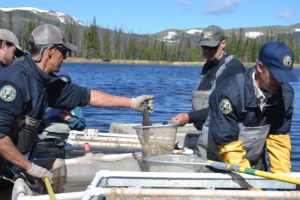 Fish were sorted based on their gender and stocking year.
Fish were sorted based on their gender and stocking year.
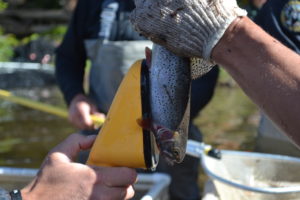 RFID chips in the fish help to identify the stocking year and other critical data.
RFID chips in the fish help to identify the stocking year and other critical data.
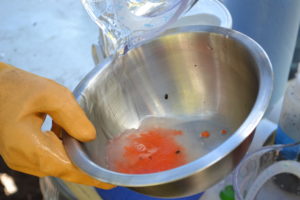 After the fish were sorted, CPW milked the males and females - making targeted genetic crosses among the various lineages to expand the genetic diversity. The eggs and sperm were combined in bowls, packed into small coolers, put on ice, and shipped to the local fish hatchery in Leadville, CO for breeding.
After the fish were sorted, CPW milked the males and females - making targeted genetic crosses among the various lineages to expand the genetic diversity. The eggs and sperm were combined in bowls, packed into small coolers, put on ice, and shipped to the local fish hatchery in Leadville, CO for breeding.
This process is a critical step in the long-term recovery of the native Greenback Cutthroat Trout. CTU is proud of the great work that its volunteers provided during these long days up at the lake. The work undertaken at Zimmerman will help ensure that future fishermen and women are able to chase these rare fish throughout the Front Range for decades to come.
For more information on the project or to get involved with other upcoming Greenback recovery projects, contact Dan Omasta, CTU Grassroots Coordinator (domasta@tu.org).
Corps approves permit for Moffat Project in Colorado headwaters
The Army Corps of Engineers gave its approval to Denver Water's proposal to expand Gross Reservoir in Boulder County in order to firm its Moffat System water supplies from Grand County. While the project will increase total diversions from the Colorado headwaters, Denver Water has incorporated mitigation and enhancement measures to the project that local TU members in Grand County believe can actually improve the Fraser River's health. As part of its commitments under this permit and the associated mitigation and enhancement plans, Denver Water will manage diversions to help provide needed flushing flows on the Fraser and its tributaries, complete habitat and native trout restoration work in the Williams Fork basin, and contribute funds toward ongoing habitat improvement efforts like the Fraser Flats project.
“The Fraser is a river beloved by generations of anglers, boaters and other outdoor enthusiasts —it’s the lifeblood of our community,” said Kirk Klancke, president of TU’s Colorado River Headwaters chapter in Fraser and a longtime advocate for the river. “As an angler and Fraser Valley resident, I’m gratified that this agreement keeps our home waters healthy and flowing.”
Most significantly, Denver Water will participate in an adaptive management program called "Learning by Doing" through which Denver, Grand County, Trout Unlimited, and other local stakeholders are cooperating to apply mitigation and enhancement resources, monitor river and watershed conditions, and make adjustments to achieve the best results over time. "Rather than remaining an adversary, Denver Water has joined us and our west slope partners as a partner working to improve conditions in the Fraser watershed," explained Colorado TU Executive Director David Nickum.
In addition to the Learning by Doing effort, Denver Water has also pledged resources for improvement work on South Boulder Creek and on the North Fork South Platte (which will be impacted by ripple effects from Gross Reservoir expansion on Denver's systemwide operations, including the Roberts Tunnel). 5000 acre-feet in the enlarged reservoir will also be reserved as an environmental pool to be managed to help provide instream flows at key times to downstream reaches of South Boulder Creek.
Behind the Fin: Blake Fanning
How long have you been a TU member?I’ve been a member for 8 years, joining after moving to Colorado. However, I really only started getting active in the past few years.

Why did you become a member and what chapter are you involved with? My grandfather taught me to fly fish when I was 8, learning on the streams in the Silverton, CO area. And my mother taught me to be in tune with the environment and how harshly man has treated it. So TU was a natural fit with those passions. I’m a member of the Collegiate Peaks Chapter in the Arkansas valley.
What made you want to become involved with TU? In addition to my lifelong pursuit of fly fishing for trout, and love of mother nature, it was a selfish reason. I wanted to learn how to fish the Arkansas river and figured the folks at our chapter could show me how to do so. It’s not the easiest of rivers to catch fish on.
What is your favorite activity or project that you have done with TU? I’m going to the CTU youth conservation and fly fishing camp in June as a volunteer. I think it will be awesome learning from many experts on river ecology, as well as helping excite the next generation on river conservation and fly fishing.
I know you won’t tell me your top spot, so what is your second favorite fishing spot or favorite fishing story?
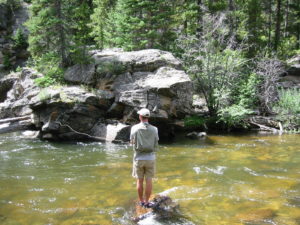 I’ve really started to love high alpine lakes, particularly backpacking into them. The solitude and natural beauty always recharges my batteries. Plus I have learned enough to usually catch some wild trout for supper. My favorite river fishing is on a stretch of the Colorado River, where my brother and I catch 18-20+ inch rainbow and brown trout. I will leave that stretch unidentified per my brother’s request.
I’ve really started to love high alpine lakes, particularly backpacking into them. The solitude and natural beauty always recharges my batteries. Plus I have learned enough to usually catch some wild trout for supper. My favorite river fishing is on a stretch of the Colorado River, where my brother and I catch 18-20+ inch rainbow and brown trout. I will leave that stretch unidentified per my brother’s request.
What does being a part of TU mean to you? It means being involved in a community of men and women whom share the common goals of conservation and fly fishing. Youth education and teaching kids to fish is a definite plus.
What else do you do in your spare time or for work? 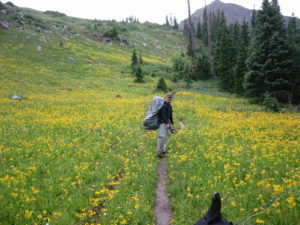 Since moving into the mountains, I have started a new career in elder care, trying to keep folks in their homes. A new focus of my fishing is the 9 wt rod I recently purchased. I’m getting into kayak fly fishing for larger fish in the Florida flats and will be fishing for some pike this summer on the Rio Grande. Love new adventures.
Since moving into the mountains, I have started a new career in elder care, trying to keep folks in their homes. A new focus of my fishing is the 9 wt rod I recently purchased. I’m getting into kayak fly fishing for larger fish in the Florida flats and will be fishing for some pike this summer on the Rio Grande. Love new adventures.
A rancher’s vision of home waters
Home waters.
For Colorado rancher Paul Bruchez, the phrase means more than a favorite local fishing stretch, although that’s part of it.
His home waters encompass a larger vision of waters that bind a community, and a way of life.
He’s spent much of his life along the Upper Colorado River, which winds through his family’s ranch near Kremmling and waters the pasture that supports the family’s cattle operation.
Paul also is a part-time fishing guide in the valley. “Only a rancher would be smart enough to supplement their income by being a fly-fishing guide,” he deadpans.
He loves ranching and fishing, and grew up immersed in both, but he knows this way of life depends on the river—and for decades, the Colorado River here has been in decline. Because of transmountain diversions to Front Range cities, drought, and other factors, he watched as the river dropped, leaving local ranchers’ irrigation pumps high and dry.
To his credit, Bruchez quickly realized that this was more than an irrigation problem. He found a study by a Colorado parks biologist that described seriously degraded river habitat in this stretch, including the loss of key health indicators such as riffle structures and stoneflies. In recent decades, the riffles and bugs had disappeared and been replaced with silt, steep eroded banks and what Bruchez calls “frog water”—slow, murky and mossy.
Looking at the degraded stretch left Bruchez wondering, “What happened to our river?”
So, a few years ago, he decided to do something about it. He talked with his neighbors about not just fixing their irrigation systems but actually fixing the river. Instead of replumbing the irrigation down to reach the river, he had the audacious idea of bringing the river levels back up. He wanted to restore flows and habitat for miles in the valley. He wanted a healthy river.
He began talking with Trout Unlimited and American Rivers. They put their heads together and came up with some innovative ideas. They launched a pilot project: on a neighbor’s ranch just outside of Kremmling, the partners brought in gravel and rocks to rebuild a point bar and reconstruct a riffle: the idea was to boost the oxygen in the water and provide cooler refuge for trout in the pool. Upstream of the riffle V, the narrower channel would back up the water, raising levels and making it more available for irrigation intakes.
At least that was the idea. Then they built it, and surprise—it worked.

The new riffle.
Bruchez likes to look at the riffle, which froths and rattles over gravel and then slides into a deep long run and is a thing of beauty. “It looks fishy now,” he says.
Almost immediately, the bugs came back. In fact, he recently scooped up a Mason jar of the big stoneflies and other bugs—like some homegrown canned goods—and took them to a meeting of the Colorado Basin Roundtable, a local water planning group for the state. Paul held up the jar and said: This is what river conservation success looks like. With a little help, he told them, the bugs will return, and with them, the foundation of the entire food chain in the river.
He and his neighbors now have funding to improve 10 miles of the river with riffle-pool structures and other habitat projects.
“These bugs will replenish themselves fairly quickly once the river is restored,” he says. And the trout will follow.
It’s working—in fact, it’s astonished him how quickly nature has responded to their efforts. A few weeks back, he took a Colorado senator to the original riffle project. As they looked at the rippling water and tailout, trout began popping everywhere on the surface, rising to a prolific bug hatch.
It was incredible timing. The senator was impressed.
Those rising trout were a vision of the future.
He holds on to those moments, because restoring home waters isn’t always glamorous work. He’s put in countless hours in recent years attending godawfully long planning meetings and crunching the mind-numbing details of construction budgets. He credits his family for covering for him on some of the ranching duties, allowing him to pursue his river work. His wife has been patient.
They understand it’s about keeping their family in this valley. Home waters.
Paul knows that their life here always comes back to the river. He wants to keep it flowing. He wants to keep it fishing. He wants to turn over rocks at the riffle’s edge and find crawling signs of life. That’s what victory looks like.
For more pictures and story on the Bruchez ranch project, read the upcoming issue of This is Fly Magazine.
The author of this piece, Randy Scholfield, is TU's director of communications for the Southwest.
Clean Water Rule Unraveled
The Environmental Protection Agency (EPA) officially proposed today to rescind the so-called Clean Water Rule, established under President Obama in 2015. This action begins a process of unraveling years of work to protect some of the most critical streams and wetlands in our country. The agency is giving Americans only 30 days to weigh in on a rule that took years to craft. The Clean Water Rule was a scientifically sound set of regulations that made clear America’s headwater streams would be protected for water quality under the federal Clean Water Act. The rule also would have reaffirmed exemptions in existing law for landowners and agricultural operations. It was strongly supported by the vast majority of Americans who commented on it during its multi-year development process..
In contrast, today's action to rescind the rule jeopardizes 60 percent of stream miles in the U.S., those small tributaries (sometimes ephemeral) to larger rivers which provide important habitat for fish and wildlife and deliver clean water to some of our most treasured fishing grounds.
But fishing isn't the only thing at stake. This move impacts the sources of drinking water for 117 million people. That's one in three Americans whose drinking water originates in a stream that may no longer be protected.
Our access to clean water in this country is one of the things that sets us apart from many nations in the world. And it is up to protect the places that supply high quality water.
There's no doubt the Clean Water Rule has created much division. Trout Unlimited has seen that first-hand in working with many of our partners in agriculture. We understand and agree with the importance of getting this rule right, and support the exemptions granted to the ag community.
But as an organization that works daily to fix polluted streams and rivers -- and the fisheries such pollution has degraded or ruined -- we know too well how hard and expensive it is to fix something rather than protect it in the first place.
"Clean water is not a political issue," said Chris Wood, President and CEO of Trout Unlimited. "It is a basic right of every American. Water runs downhill and gravity works cheap, and never takes a day off. We all live downstream. To be effective, the Clean Water Act must be able to control pollution at its source, upstream in the headwaters and wetlands that flow downstream through communities to our major lakes, rivers, and bays. EPA’s action places the health of 60 percent of the stream miles in the U.S. at risk. Trout Unlimited intends to work with our hundreds of thousands of members and supporters to reverse course on this misguided direction."
The Clean Water Rule is a foundational American law, one meant to protect the health of our nation's citizens. It also helps ensure that our remaining cold water habitat can provide good habitat and fishing opportunity. Time is short: Let's get to work.
Trout Unlimited Recipient of WaterSMART Watershed Management Projects
The Bureau of Reclamation has awarded $664,754 to seven entities to implement watershed management projects in five states. Trout Unlimited received funds for three different projects including two in Colorado. In cooperation with the Five Rivers Chapter of Trout Unlimited, the Animas Watershed Partnership will receive $83,137 for a total project cost of $167,169 to conduct stream restoration projects in the lower Animas River near Farmington, New Mexico. Others providing contributions to this project are the Ranchmans-Terrell Ditch Association, San Juan Soil and Water Conservation District, and Basin Hydrology Inc.
The Eagle River Watershed Council, Inc., will receive $90,000 for a total project cost of $1,363,500 to improve instream flows in Abrams Creek, southwest of Eagle, Colorado. This project is being completed in conjunction with Trout Unlimited, Colorado Parks and Wildlife and Buckhorn Valley Metropolitan District.
In Idaho, Trout Unlimited also partnered with the Boise River Enhancement Network which will receive $100,000 for a total project cost of $398,845 will expose the lower 440 feet of Cottonwood Creek that flows through downtown Boise. The City of Boise, Land Trust of Treasure Valley, Intermountain Bird Observatory and the Ada County Highway District are contributing to the non-federal cost share.
The funding will be used for projects that enhance water conservation, improve water quality and ecological resilience, reduce water conflicts, and advance goals related to water quality and quantity. The entities that received the funds are also contributing funds to complete these projects.
"Cooperative watershed groups bring together diverse partners to address water management needs in their local communities," Bureau of Reclamation Acting Commissioner, Alan Mikkelsen, said. "The projects announced today will help restore watersheds and reduce water conflicts that were collaboratively developed within their communities."
Read about the other project recipients here.
WaterSMART is the U.S. Department of the Interior’s sustainable water initiative that uses the best available science to improve water conservation and help water resource managers identify strategies to narrow the gap between supply and demand. To learn more about WaterSMART, please visit https://www.usbr.gov/watersmart.
CPW staff spawn unique cutthroat trout rescued from Hayden Pass fire
Colorado Parks and Wildlife press release GUNNISON, Colo. – Inside Colorado Parks and Wildlife’s Roaring Judy Hatchery, the staff is working to save and breed 158 unique cutthroat trout rescued from Hayden Creek during last year’s devastating Hayden Pass wildfire, southwest of Cañon City.
Throughout June, hatchery technicians have artificially extracted milt and roe – semen and eggs – from the unique cutthroat trout, which were first discovered in Hayden Creek by CPW biologists in 1996. Today they may be the last survivors because no fish were found in an initial survey of the South Prong of Hayden Creek in the aftermath of the wildfire and subsequent flooding.
The fire erupted from a lightning strike last July 8 and roared out of control for weeks, eventually charring 16,754 acres across the Hayden Creek and Big Cottonwood Creek drainages above the Arkansas River near Coaldale.
At the time, CPW staff and U.S. Forest Service (USFS) volunteers made a desperate dash behind the fire lines and captured roughly half of the cutthroats believed to be living in a one-mile stretch of the South Prong.
Of the rescued trout,158 were taken to Roaring Judy and placed in isolation. The other 36 were released in Newlin Creek south of Cañon City with a goal that they would reproduce naturally.
Several hundred fish were left behind in hopes they would survive and the monsoon rains would spare the drainage. Heavy rain events after a fire can inundate streams with debris, ash and sediment making it difficult for fish to survive and reproduce.
Indeed, soon after the fire, fall monsoons ravaged the watershed. Biologists returned to the area with sampling gear and could not find a single fish. They plan to return to the creek this fall in hopes of finding a few hardy survivors .
The Hayden Creek cutthroat are unique and different than the famed pure greenback cutthroat residing in Bear Creek, on the western edge of Colorado Springs. Those trout, which ironically are native to the South Platte River basin, were once thought to be extinct in the 1930s. A study headed up by scientists at CU Boulder in 2012 revealed that the only true greenback cutthroat resided in Bear Creek. That information led to the propagation and eventual reintroduction of those fish into several streams and one lake in the South Platte basin.
The cutthroat trout in Hayden Creek, and now in the hatchery, are unique and contain genes matching museum specimens collected by early explorers. In 1889, ichthyologist David Starr Jordan collected a pair of trout specimens from Twin Lakes, near Leadville. Today those specimens reside at the Smithsonian Institution's National Museum of Natural History. The Hayden Creek cutthroat trout are the only known modern fish to share their genetics.
“The coordination that occurred between the USFS staff and CPW to rescue these fish from the wild during an active fire was truly amazing,” said Josh Nehring, CPW senior aquatic biologist. “Furthermore, our staff at Roaring Judy, lead by Seth Firestone, has provided exceptional care to these fish. It is not an easy task to take a wild fish into the hatchery and get them to survive let alone reproduce. Kudos to that team!”
Their spawning efforts began June 12 in the isolation unit located along the East River, north of Gunnison.
Firestone, hatchery manager, said roe was stripped from 10 female cutthroat and mixed with milt from 10 males the first day. Action continued June 19 and the staff is hopeful for more success the week of June 26.
But the rescue is not without risk. The trout are being treated for fungus attributed to male aggression.
“It’s a concern,” Firestone said, describing how the fish are receiving weekly baths in a mild saltwater solution to combat the fungus. “We are doing our best to keep it under control.”
2017 Youth Camp Recap
Over the week of June 11 to June 16, campers from all over the state joined at the Bar N I Ranch in Stonewall, CO for the 2017 Colorado TU River Conservation and Fly Fishing Youth Camp. For the entire week, 15 campers between the ages of 14-18, joined Colorado TU staff, volunteers and camp counselors for a week of camping, learning, and fishing- for some of the kids, it was their first time ever fishing. The kids took part in various activities teaching them all about river conservation, native trout species, Western water issues, and of course, all things fly fishing.
The students arrived on Sunday, June 11 and right away the fun started. After the campers got their tents set up, the camp staff and counselors went over basic information about the camp, rules, and an overview of what to expect. After the orientation, the kids then got a chance to know one another. Finally, they learned about some basic fly fishing techniques including how to tie knots and when to use them and the basics to casting. The first day also covered some of the current river and water issues in Colorado.
 Monday was the first full day of camp and after waking up, the kids went to the stream and pond at the ranch to learn about the entomology of the watershed. The kids took bug samples to learn about what the fish would be eating in the area and took water samples to determine the health of the stream and pond. After the sampling, students ate lunch and headed to nearby North Lake to fish for the afternoon. It wasn't long before kids started hooking into fish and in the first day over half of the kids had landed their first fish of the camp and for some, their first fish ever.
Monday was the first full day of camp and after waking up, the kids went to the stream and pond at the ranch to learn about the entomology of the watershed. The kids took bug samples to learn about what the fish would be eating in the area and took water samples to determine the health of the stream and pond. After the sampling, students ate lunch and headed to nearby North Lake to fish for the afternoon. It wasn't long before kids started hooking into fish and in the first day over half of the kids had landed their first fish of the camp and for some, their first fish ever.
On Tuesday, June 13, the campers and camp staff headed to Alamosa to visit the Sand Dunes National Park. While at the Sand Dunes, the campers visited with National Park staff and Trout Unlimited's Kevin Terry to learn about the Rio Grande Cutthroat Trout and how climate change is affecting the habitat of this species. During the trip to Alamosa, students also visited the Native Aquatic Species Hatchery, a facility based around the restoration of Colorado’s native species. Here, campers were exposed to the science behind genetics, and were able to see what it takes to bring back a species from endangerment. Tuesday wrapped up with a lesson on western water law and the issues affecting the region's most valuable resource.
 Over the first few days the kids had free time to tie flies and practice their fly fishing skills and on Wednesday they had a chance to hone in those skills and use the flies they have tied. The day started off by traveling to North Lake for the morning. While at North Lake kids were catching fish left and right and by halfway through the morning, everyone had caught a fish. After returning to the camp, the kids ate lunch and broke up into teams of three for some additional fishing. One group headed to some beaver ponds, another group fished the stream, and the third group fished a lake on the ranch property.
Over the first few days the kids had free time to tie flies and practice their fly fishing skills and on Wednesday they had a chance to hone in those skills and use the flies they have tied. The day started off by traveling to North Lake for the morning. While at North Lake kids were catching fish left and right and by halfway through the morning, everyone had caught a fish. After returning to the camp, the kids ate lunch and broke up into teams of three for some additional fishing. One group headed to some beaver ponds, another group fished the stream, and the third group fished a lake on the ranch property.
Thursday, the last full day of the camp, consisted of a lesson from Colorado Parks and Wildlife on aquatic nuisance species and how anglers can do their part to protect our watersheds from these invasive species. Colorado Parks and Wildlife also lead a trout dissection for campers to learn about the biology of trout. Later in the afternoon, the National Resources Conservation Service (NRCS) brought a soil trailer to demonstrate watershed issues on a smaller scale. The students were able to see how issues of erosion, wildfires, and flooding can affect an entire watershed. After dinner on Thursday the campers watched the 2017 Fly Fishing Film Tour at the local Pinion Valley Lodge.
On the last morning of the camp, the campers helped pick up the fly tying and fishing material and break down their camps. Soon, parents were arriving for the closing ceremony. Campers, staff, and parents had a chance to comment on their experiences with the camp.
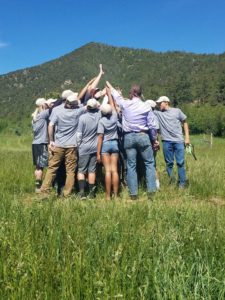 When the 15 campers arrived on June 11, there were nervous faces and uneasy feelings about what to expect for the upcoming week. But just a few days later on June 16 the campers had a hard time leaving one another. The friendships formed, the lessons learned, and the memories made will carry on forever and many students mentioned coming back in 2018.
When the 15 campers arrived on June 11, there were nervous faces and uneasy feelings about what to expect for the upcoming week. But just a few days later on June 16 the campers had a hard time leaving one another. The friendships formed, the lessons learned, and the memories made will carry on forever and many students mentioned coming back in 2018.
Colorado TU wants to thank the campers, parents, volunteers, chapters, and all of the guests who helped make this camp a great success. The camp could not have been done without your support and we look forward to working with you all next year! CTU also wants to thank the Bar N I Ranch for their hospitality during the course of the week!
We hope to see many new and old faces at the camp in 2018!
Greenback Recovery Working Group
The greenback cutthroat is one of last three remaining species of cutthroat trout that is native to Colorado. Their populations were decimated during the initial settling of the west, and for a period of time this species was thought to have become extinct. Later, greenback cutthroats were believed to have been rediscovered, but this proved to be case of mistaken identity. Genetic testing later provided evidence that this “old Strain” of greenback cutthroats were in fact Colorado Cutthroats, an entirely different subspecies of cutthroat trout. It wasn’t until later that a small population of true native greenback cutthroat were discovered in Bear Creek near Colorado Springs. Since this discovery there has been a significant effort to capture the genetic pool of these true greenback cutthroats, breed them in controlled environments, and repopulate native waters with these trout. Much of this work is thanks to the Greenback Recovery working group, currently lead by Colorado TU Grassroots Coordinator, Dan Omasta. This working group is a collaborative effort; including organizations such as Trout Unlimited, the Division of Fish and Wildlife, the Forest Service, and front range CTU chapters. This partnership forms a unified front to work as a single point of contact. The Greenback Recovery Working Group has been effective because they are able to provide much needed volunteers, address funding needs, enhance communications, and work on grant writing across chapters as a single entity.
One of the most significant ongoing projects is the reintroduction of native greenback cutthroat trout to Zimmerman Lake. This lake serves as a spawning ground for these cutthroat, where fertilized eggs are then collected and brought to the Leadville hatchery. The resulting fry are then reintroduced to other native streams.
Another substantial project conducted by the Greenback Recovery Working Group in partnership with Western Native Trout Initiative entails installing 30 temperature loggers into local streams. This project will help Colorado Trout Unlimited collect data in order to evaluate streams for reintroduction, monitor progress, and over time measure the impacts of climate change. There are many other ongoing and upcoming projects that the Greenback Recovery Working Group is tirelessly working on in order to successfully reintroduce native greenback cutthroat trout.
Soon under the Endangered Species Act, the Department of Fish and Wildlife will be forced to review the status of greenback cutthroats. Currently greenback cutthroat trout are listed as a threatened species, but if they are downgraded to an Endangered species there could be significant consequences. It would take significantly more time and money to acquire permitting and conduct environmental impact assessments. Additionally, if this species becomes endangered, it may no longer be targeted by anglers. This may provide disincentives to protecting this native cutthroat species and limit fishing areas across Colorado. This would hinder one of the most substantial trout recovery efforts even undertaken in Colorado, but with proper funding and volunteers the Greenback Recovery Working Group should continue to successfully reintroduce this cutthroat species thought to have been lost.
To get involved or volunteer please contact Dan Omasta, DOmasta@tu.org, to learn about various opportunities!

